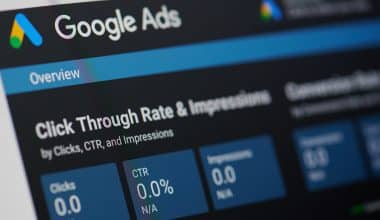Creating a marketing strategy is crucial for successfully nurturing clients. It is also good for enhancing your company’s bottom line and increasing the return on your efforts. In this article, I will discuss my experience developing an effective marketing strategy that resulted in genuine growth, as well as provide examples and templates when needed. I’ll keep things basic and walk you through the main steps I followed.
Whether you want to improve your present marketing strategy or start from scratch, you’ll discover simple advice for creating your own strategy to achieve your objectives. My goal is to present you with the critical information you need to develop a winning strategy.
What is a Marketing Strategy?
A marketing strategy encompasses a company’s holistic approach to effectively promoting its brand to a specific audience. The process entails conducting thorough research, establishing clear goals, and strategically positioning oneself.
When I put together a marketing strategy, I make sure to cover all the important elements. Which are clear brand objectives, personas of the target audience, various marketing channels, key performance indicators, and other important elements.
You should also know that a marketing strategy will:
- Ensure that your team is focused on achieving specific objectives.
- Assist in aligning your efforts with business objectives.
- Enable you to discover and experiment with what connects with your intended audience.
- Empower you to capitalize on emerging trends.
It is crucial to emphasize the significance of the last one. Staying updated with marketing trends is crucial for your strategy, but it can easily become a full-time commitment.
It’s fascinating to see how much the marketing industry has evolved in recent years. According to a survey, nearly 80% of marketers believe that the industry has experienced more significant changes in the past three years than it has in the previous five decades. This statistic highlights the rapid pace of transformation and the need for marketers to stay updated with the latest trends and strategies.
Key Takeaways
- Marketing is more than simply advertising and marketing; it’s all about interacting with your customers.
- A marketing strategy directs all of your product development and marketing efforts.
- Having a marketing strategy keeps all of your operations on track.
- Setting goals, conducting market research, creating product strategies, defining marketing efforts, and adhering to the “4 P’s” are all part of developing a marketing strategy.
Benefits of a Marketing Strategy
Based on my personal experience, I’ve found that without a clear plan in place, it can feel like I’m just randomly trying different approaches to see what works. And going through that process can be quite expensive, time-consuming, and resource-intensive.
However, a strong marketing approach will reach your intended audience. It has the potential to convert those who have never heard of your business into devoted repeat clients.
I will share with you some of the key reasons why having a marketing strategy is absolutely crucial:
#1. Offers Direction
A marketing plan sets specific goals and the road to achieving them. It coordinates all marketing initiatives within an organization for maximum effectiveness.
#2. Targets the right audience.
A well-defined marketing plan assists you in identifying and understanding your target demographic. This allows your organization to adapt its messaging and positioning to reach the appropriate individuals at the right time.
#3. Develops brand identity.
A marketing plan enables you to develop a consistent and integrated brand identity. This facilitates the alignment of all marketing initiatives aimed at increasing brand recognition and loyalty.
#4. Maximizes ROI
Marketing strategies assist firms in determining the most effective marketing channels and approaches to invest in by analyzing market trends, competition, and customer behavior. This allows firms to receive the most return on investment.
#5. Evaluates Performance
A marketing plan outlines critical metrics and performance indicators. This makes it easy for your company to measure and track the effectiveness of marketing campaigns. It also provides the tools you need to make data-driven decisions and optimize future campaigns for better results.
Marketing Strategy vs. Marketing Plan
Understanding the distinction between a marketing strategy and a marketing plan is crucial. A marketing strategy sets the stage for long-term goals and provides a comprehensive approach, while a marketing plan delves into the specific actions and tactics required to achieve those goals.
In other words, the marketing strategy directs the overall marketing initiatives of a business. It involves setting goals, conducting market and competitor research, and developing messaging and positioning for a brand.
I will make you see this from a different angle. Now, let’s consider a scenario where you’re developing a marketing strategy for a fresh fashion brand. Perhaps your approach could focus on appealing to young urban professionals by presenting the brand as both fashionable and budget-friendly.
However, a marketing plan serves as a comprehensive strategic guide. It provides a detailed plan of action and strategies to successfully accomplish the goals of the marketing strategy.
As an illustration, the marketing plan for the fashion brand mentioned earlier could encompass:
- Targeted social media campaigns
- Influencer partnerships
- Online advertising timeline
Having both a marketing strategy and a marketing plan is crucial for the success of any business.
To thrive in the dynamic marketing industry and connect with your audience effectively, it is crucial to stay ahead of the game.
To help make this process more tangible, I’m providing a free marketing plan template. This practical template has been a game changer in my experience, offering a step-by-step roadmap for developing effective marketing strategies.
I understand that uncertainty can be overwhelming, so I am here to guide you through the process of creating a comprehensive marketing strategy, step by step. Now, let’s delve into the specific elements that contribute to a robust marketing strategy.
What is Included in a Marketing Strategy?
A marketing strategy involves analyzing a company’s current value position and charting a future marketing direction. Typically, it includes:
#1. Marketing Mix
Understanding the marketing mix is crucial for any marketer. It serves as a preliminary document that helps you determine what, where, and how you will market your product or service. This framework is composed of the following 4P‘s:
- Product: What are you selling?
- Price: What is the price?
- Place: Where will you be selling the product?
- Promotion: Where will you be promoting the product?

I am telling you this right now: By taking this information into account, you can develop a comprehensive marketing strategy tailored to each promotional channel. Understanding the big picture of your marketing strategy is crucial. It helps you see the overall direction and make informed decisions.
#2. Marketing Objectives
You have the option to establish your marketing objectives either in conjunction with your 4 Ps or immediately following them. Regardless, it is important to establish your marketing objectives prior to developing your strategy. Why? Because your objectives will influence various aspects of the plan, such as the financial allocation and the process of developing content.
It is important to be as specific as possible with every objective. Consider developing specific marketing goals for each channel or promotional tactic, and remember that it’s important to regularly review and update your goals to align with changing priorities. I keep telling you this.
#3. Marketing Budget
Your strategy requires an essential element: a marketing budget. If you don’t invest in recruiting the right talent, utilizing the appropriate software, promoting on the correct channels, and developing compelling content, your marketing strategy will not yield significant results. In order to achieve a significant return on investment, one must make an initial investment.
I always recommend starting small and hyper-focusing your budget on one or two efforts. Once you generate an ROI, you can then build upon it. When I first established my fashion brand, I aimed to grow website traffic by 25% in six months. I budgeted $5,000 for Instagram influencer marketing based on average nano-influencer sponsorship deals. This enabled me to collaborate with relevant influencers to increase traffic.
#4. Competitive Analysis
Understanding the competition is crucial when developing a marketing strategy. Otherwise, one may risk speaking without achieving measurable results. Additionally, it can be challenging to gauge if you are truly standing out from your competitors and successfully capturing the interest of your target audience.
I have a feeling that you may already have some thoughts on who your competitors are, but it’s crucial to take the time to sit down and identify them. It’s possible that you may come across an unexpected competitor who is competing for the attention and engagement of your target audience.
#5. Segmentation, Targeting, and Positioning
Segmentation, targeting, and positioning (STP) is the process of sending “more relevant, personalized messages to target audiences.” In other words, rather than producing blogs and advertisements on a whim, you’ll follow a scientific procedure to create content that appeals to your target buyer.
For example, when I was developing a marketing strategy for my fashion brand aimed at young urban professionals, I conducted surveys and studied consumer data to discover that 60% of our target population spends their time on Instagram and Facebook. This allowed me to tailor my strategy to focus on those platforms.
#6. Content Creation
After obtaining your budget, competitive outlook, and STP information, it is time to craft your marketing content. However, it is crucial to approach this strategically. Firstly, it is important to avoid publishing random content that does not address the needs of your customers. Secondly, it is crucial to take advantage of emerging trends in order to increase the visibility of your brand in the marketplace.
When implementing my fashion company marketing plan, I chose Instagram and Facebook as my key channels based on audience research. Paid advertising on these platforms generated over 100,000 new site sessions within 6 months – a 28% increase in traffic.
#7. Metrics and Key Performance Indicators (KPIs)
Lastly, it is important to include metrics and key performance indicators in your marketing strategy to gain a better understanding of the effectiveness of your strategies. Choosing the KPIs will depend on the type of business you have and your personal preferences.
How I Create a Speculating Marketing Strategy
When it comes to creating a marketing strategy, I have found that there are several steps that you should consider. They include:
#1. Identify your goals
While sales are important for every company, it is also crucial to set short-term goals that focus on establishing authority, increasing customer engagement, or generating leads. These goals can help drive success and growth in the long run. By setting smaller goals, you can easily track the progress of your marketing plan. When it comes to strategy, I like to think of it as the overarching ideology that guides your actions. On the other hand, planning is all about the practical steps you take to achieve your goals.
#2. Know your clients
Understanding your target audience and their preferences is crucial for any product or service. It’s important to have a clear picture of who your customers are and where they can be found. If power tools are your specialty, marketing channels that target general contractors would be the ideal choice for showcasing your messaging. Determine your client’s identity and illustrate how our product can enhance their daily experiences.
#3. Create your message
Here is an opportunity for you to demonstrate to potential clients the ways in which your product or service can bring them benefits and why your company is the exclusive provider of such offerings.
#4. Define your budget
The way in which you distribute your messaging may vary depending on your budget. Are you planning to invest in advertising? Looking to go viral on social media naturally? Is it possible to send out press releases to the media in order to gain coverage? The extent of your options will be determined by your budget.
#5. Determine your channels
Choosing the right platform is crucial for delivering a message effectively. I know that creating blog posts for a company’s website can provide significant value. Due to my experience, I have also found that utilizing paid ads on social media channels can be quite effective. So just go ahead and discover the perfect venue for your content.
#6. Assessing your achievements
Tracking performance indicators is critical for determining marketing effectiveness. When I implemented my fashion brand strategy, I kept track of website sessions, cost per click, and conversion rates. My cost per click reduced by 22% as I optimized campaigns, and landing page conversion rates increased by 15%.
Examples of Successful Marketing Strategies
Let’s take inspiration from industry titans like Airbnb, Disney, and Pepsi. By delving into their techniques, you can gain actionable insights that go beyond conventional wisdom, thus enhancing your own marketing efforts.
#1. Airbnb’s Marketing Strategy

Airbnb takes advantage of four distinct tactics. Airbnb is a software firm that allows people to rent out properties, such as houses and apartments, as an alternative to typical hotel accommodations. The four methods are: building community through focused outreach, using user-generated content, focusing on a clear and unique value offer, and establishing a referral scheme.
#2. Disney’s Marketing Strategy
It also employs four strategies to distinguish its items from the competition. Disney is an entertainment firm that produces movies and television shows, physical entertainment centers, and amusement parks, as well as clothing and toys to complement its film productions. Disney distinguishes itself by producing stories that resonate and inspire, leveraging nostalgia to reinforce consumer loyalty, targeting audience segments through a multi-channel strategy, and being committed to its very distinct brand.
#3. Pepsi’s Marketing Strategy

Pepsi stands out for its branding, sponsorships, endorsements, social media interactions and collaborations, and willingness to take chances to stay current.
What Are the 4 Types of Marketing Strategies?
Marketing plans are mostly comprised of these important aspects known as ‘the 4 P’s of marketing. They are product, price, placement, and promotion.
What Are the 5 Marketing Strategies?
These are the four Ps of marketing: product, price, promotion, and place, with a fifth part added recently: people.
Why Does My Company Need a Marketing Strategy?
The purpose of all marketing is to induce lucrative consumer action. The more efficiently you market your company and items, the more returns and client base you will be able to generate over time.
Conclusion
In my experience, developing a comprehensive marketing strategy takes time and careful consideration. Confirming that you’re reaching your ideal audience, whenever and wherever they want to be reached, requires time, hard work, and dedication.
Keep at it and utilize some of the resources I provided in this post, and with time, research, and customer input, you can fine-tune your approach to focus on the marketing channels that matter most to your audience.
- Everything You Need to Know About Marketing Objectives
- MARKET DEVELOPMENT STRATEGY: What It Means, Examples & Guide
- MEDIA PLANNING: What Is It & Why Is It Important?
- CHANNEL MANAGEMENT: Meaning, Examples & Why It Is Important






